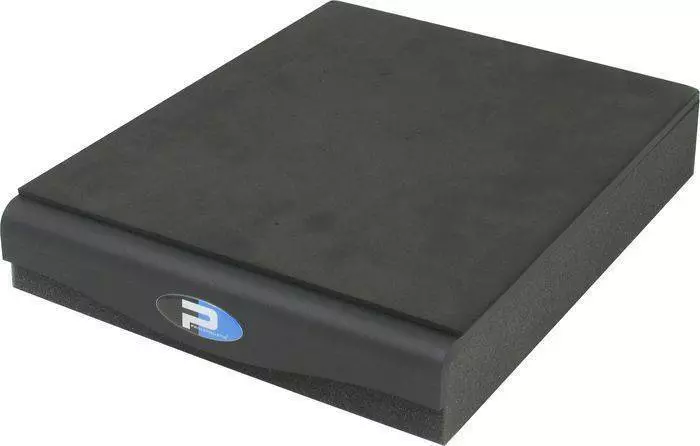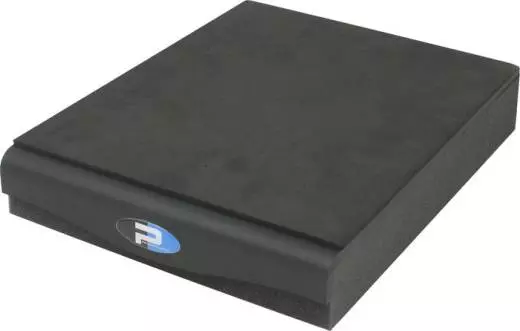Opens in a new window
Primacoustic Recoil Stabilizer - 10.5x13 Inches (Horizontal)

Before we get into how the 'Recoil' works, it is worth understanding some of the scientific principles involved and what problems we are actually solving.
Sound travels through air and other mediums in waves. These waves compress at various frequencies called the wavelength. Longer wavelengths tend to travel further while shorter ones travel in a more direct line. Longer wavelengths require more energy to generate and once in motion, are very difficult to contain. With sufficient energy, long wavelengths will cause walls and floors to vibrate. Thunder shaking your house is a very good example of lots of energy applied to a low frequency.
Simply put, bass travels through just about anything while high frequencies are fairly simple to control. And what has all of this got to do with nearfield monitors or reference loudspeakers? Speakers produce bass frequencies that will transfer vibrations through the speaker stand to the floor, the walls and what ever else is physically connected to the speaker. This is called acoustic coupling. When sound vibrations couple with the speaker stands they resonate and produce unwanted sound coloration. To sum up, coupling causes a frequency bump at the resonant frequency which in turn changes the speaker's performance.
To solve the problem, engineers often employ urethane foam pads or other insulating materials under their nearfield reference monitors as a means to eliminate the acoustic resonance that occurs when the speaker and the speaker stand, (shelf or monitor bridge) couple. Good news- this does in fact effectively decouple the two devices. Bad news- it introduces a new problem that is best described as recoil.
Think of a rifle firing a bullet. The hammer strikes the firing pin which in turn causes the shell to explode, propelling the bullet forward. As the bullet pushes forward the rifle recoils backwards to absorb the energy. This is exactly what is happening when you place your speakers on a soft, spongy material; during a transient such as a sharp kick drum thump, the forward momentum of the speaker is dulled by foam as the soft malleable substance allows the speaker to tilt backwards and recoil. This 'recoil' may be desirable when firing a rifle, but with a loudspeaker, the movement dulls the initial transient at the start of the wave, and the result is predictable: you lose clarity and detail.
Sound travels through air and other mediums in waves. These waves compress at various frequencies called the wavelength. Longer wavelengths tend to travel further while shorter ones travel in a more direct line. Longer wavelengths require more energy to generate and once in motion, are very difficult to contain. With sufficient energy, long wavelengths will cause walls and floors to vibrate. Thunder shaking your house is a very good example of lots of energy applied to a low frequency.
Simply put, bass travels through just about anything while high frequencies are fairly simple to control. And what has all of this got to do with nearfield monitors or reference loudspeakers? Speakers produce bass frequencies that will transfer vibrations through the speaker stand to the floor, the walls and what ever else is physically connected to the speaker. This is called acoustic coupling. When sound vibrations couple with the speaker stands they resonate and produce unwanted sound coloration. To sum up, coupling causes a frequency bump at the resonant frequency which in turn changes the speaker's performance.
To solve the problem, engineers often employ urethane foam pads or other insulating materials under their nearfield reference monitors as a means to eliminate the acoustic resonance that occurs when the speaker and the speaker stand, (shelf or monitor bridge) couple. Good news- this does in fact effectively decouple the two devices. Bad news- it introduces a new problem that is best described as recoil.
Think of a rifle firing a bullet. The hammer strikes the firing pin which in turn causes the shell to explode, propelling the bullet forward. As the bullet pushes forward the rifle recoils backwards to absorb the energy. This is exactly what is happening when you place your speakers on a soft, spongy material; during a transient such as a sharp kick drum thump, the forward momentum of the speaker is dulled by foam as the soft malleable substance allows the speaker to tilt backwards and recoil. This 'recoil' may be desirable when firing a rifle, but with a loudspeaker, the movement dulls the initial transient at the start of the wave, and the result is predictable: you lose clarity and detail.
Q & A
There are currently no questions for this product.
Reviews
There are currently no reviews for this product. Be the first to write one!





